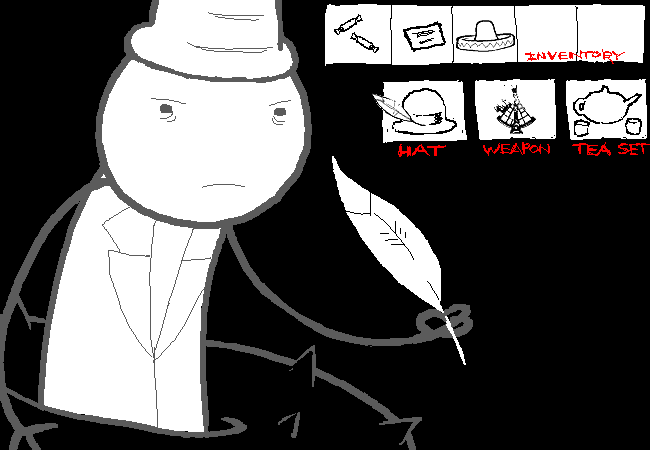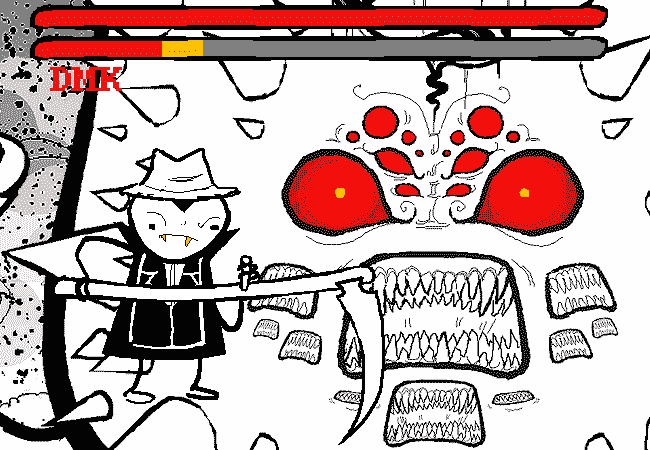You are one of the top Problem Sleuths in the city. Solicitations for your service are numerous in quantity. Compensation, adequate. It is a balmy summer evening. You are feeling particularly hard boiled tonight.
What will you do?
Image: First page of Problem Sleuth
Problem Sleuth
Problem Sleuth is a long-running webcomic by Andrew Hussie, a surrealist cartoonist who is perhaps best known for creating Homestuck.
In Problem Sleuth, we follow the adventures of a group of detectives in a world of visual gags and surrealist comedy. The story quickly escalates in absurdity, which means that by page 851 an army of time-traveling detectives is battling the Demonhead Monster Kingpin with laser beams.

Problem Sleuth is interesting to students of interactivity because it straddles the boundary between interactive and non-interactive. While it mainly follows the format of a webcomic, i.e. a non-interactive medium, Problem Sleuth is presented with the trappings of an interactive adventure game. Each page is presented as a command entered by the “player.” For example, the story opens with the command prompt telling Problem Sleuth to “> Retrieve your gun, there are dames to be rescued!”
These commands were actual suggestions from readers who participated in the creation of the webcomic in real time. Each command was posted by readers on the “MS Paint Adventures Forums” and subsequently introduced into Problem Sleuth by Hussie. This means that from 2008-2009 when it was written, Problem Sleuth was quite literally an interactive adventure game, albeit one with days between updates.

Because all input was filtered through Hussie, he still had ultimate control over the work. In a retrospective on Problem Sleuth (which is now lost on the defunct MSPA forums), he explained how he was often forced to choose between a large list of suggestions, and defaulted to suggestions which would be inherently entertaining or which would advance the plot. In a sense, he was a “game master” running his players through a world of his own design.
Ultimately, I find Problem Sleuth interesting because of how it defied conventional media, enabled audience participation, and broke genre boundaries. The techniques Hussie explored in Problem Sleuth would later be refined in his most famous work of hypermedia entertainment, Homestuck.
Problem Sleuth asks us: How can we take inspiration from other mediums and genres in our work? How can interactivity be added to traditionally static forms of media?

Fallen London

Fallen London is a browser game by Failbetter Games. It is a “Choose Your Own Adventure” role-playing game set in a creepy fantastical version of Victorian London. As a newly escaped prisoner, the player must make their own way in this strange city, experiencing setbacks and successes and ultimately creating their own legacy.
The story of Fallen London is experienced through the “storylet” system. In this system, the game is divided into discrete chunks of text called storylets. Depending on the statistics, possessions, affiliations, and knowledge of one’s in-game character, one gains access to different options to proceed, which link to different storylets. These storylets can also adjust a character’s statistics or the resources available to them, changing the options that will be available to the player in the future.
/cdn.vox-cdn.com/uploads/chorus_image/image/46406354/map-700x450.0.0.jpg)
As the player proceeds through hundreds of storylets, some available in certain locations and some provided by the “Opportunity Deck,” the player weaves an ongoing life story for their alter ego in the Fallen London universe. While the storylets are written by the Fallen London staff, the way the player proceeds through them, and the final story, is unique to the player. In other words, the player can be said to have control over their own story.
While “Choose Your Own Adventure” games are nothing new, Fallen London is unique because of its excellent writing and enormous scope. It has been critically acclaimed for its mysterious and compelling fictional world, which can be explored and interacted with in a much deeper way than many computer games thanks to the versatility of its storylet system. A Watchful player, for example, can join the University, give lectures, and perform archaeological research to uncover the mysteries of “the other cities that fell.” On the other hand, a Persuasive player can write short stories and get involved in romantic flings. Players of Fallen London thus have an enormous amount of narrative freedom in role-playing as the character they want to be.

Fallen London is an inspiration for interactive worldbuilding and immersive constructed worlds. It shows that deep interactions and emergent narratives can be conveyed through the simple medium of text. Most interestingly of all, it offers a look at how traditional fiction writing, such as Fallen London’s Lovecraftian horror, can be expanded and made more engaging with elements of interactivity.
Fallen London asks us: How can we make the audience feel connected and personally involved with an interactive space? How can we keep them engaged with an interactive work over the long term?
